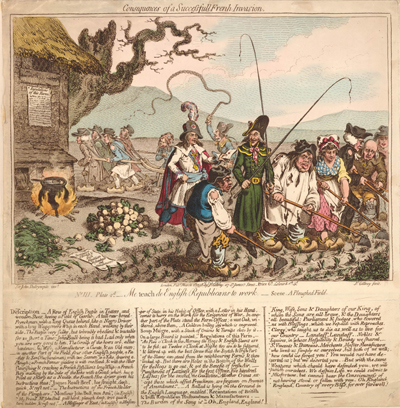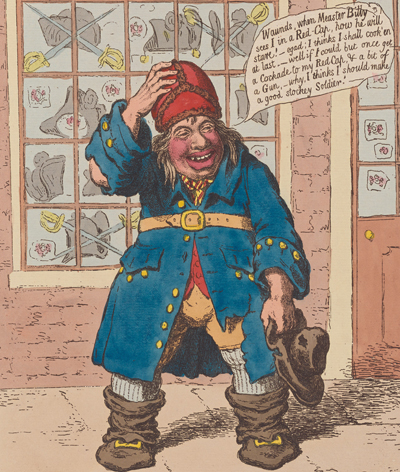Consequences of a Successful French Invasion, No 3. Plate 2nd
Me teach de English Republicans to work.
This print is part of a 20 plate series—10 Numbers of 2 Plates each—described in a Pamphlet by Sir John Dalrymple and drawn and etched by Gillray, warning about the consequences of a French invasion. For more information about the genesis, background, and other plates in the series, see my Introduction to the Consequences of a Successful French Invasion.
Only four of the projected 20 prints described in the Pamphlet were completed before the project collapsed. Gillray seems to have worked on those four prints as the spirit moved him, so although he largely followed the plan set out by Dalrymple, he did not proceed consecutively.
Me teach de English Republicans to work. is actually the second Plate of the third Number in the series. From Dalrymple's description, we know that the first plate of this third number was to be set at the Smithfield Market as the livestock to be delivered to British Butchers is seized and slaughtered by French soldiers, betraying their promises to "protect your Properties." This second Plate of the Third Number is also about betrayal—in this case the betrayal of British crop farmers and other British "Republicans" who might have thought that would have more rights under the new revolutionary regime, but instead find themselves turned into slaves in their own country.

"Me teach de English Republicans to work." [March 1, 1798]
© Trustees of the British Museum
Initially to have portrayed only farmers (husbandmen), the print, as published, depicts a representative set of British men and women, worn out and dejected, performing the most menial of tasks on the farm under what is in effect two layers of French governance—their immediate overseers with whips and prods and the central French Directory represented by the Messager d'Etat in his official state robes. (Gillray was soon to portray the full set of these official "costumes" designed by Jacques-Louis David in his Franch Habits (April 18, 1798). The dirty and tattered clothes of the British workers are starkly contrasted with the pristine, and in the case of the messenger, splendid dress of the French. Under the sign, Regulations of this Farm, a caldron supplies what is presumably the only food allowed to the British workers, a Soup Maigre, a meatless mix of the turnips and garlic stacked nearby. This is particularly galling and ironic for a nation identified with its roast beef, and this slow starvation is no doubt symbolized by the withered English oak behind the farm house.
This is one of those plates whose "Description" changed and grew considerably over the course of its production as Sir John became more pedantic and more enamoured of his creation. The original Description was no more than nine lines, mentioning only one set of English Husbandmen "in Tatters , and wooden Shoes, hoeing a Field of Garlic," overseen by a "tall raw-boned Frenchman. . . with a long Wagonner's whip in each hand." In the second iteration, at the end of his Pamphlet, Dalrymple added an extensive section of text intended to be inserted along with the original description. It included the depiction of a second set of Husbandmen in the background, their overseers with whip and goad, the arriving messenger of state, the Farm Office, oak, caldron, and other details that appear in the published Description. It also included the supposed "Regulations of this Farm" and the fictitious ballad entitled "Recantation of British & Irish Republican Husbandmen & Manufacturers." which Gillray could do no more than allude to in the visual image.
It did not, however, include the differentiating characterizations of the British workers which appear in the Description etched on the finished plate: e.g. "a Husbandman, his Wife, a Manufacturer, a Curate, & an Old man," and the "Father & Son (Husbandmen) with two Seamen." These must have been communicated to Gillray after the publication of the Pamphlet. If so, Gillray either misheard him or decided to go his own way. In the background figures, for instance, there is no obvious sign of a father and son or two seamen. And John Bull, who is mentioned as being urged on by the French ploughman, appears not among the background figures, but rather as the Husbandman next to his wife in the row of hoers. The John Bull there looks most like the one in Gillray's La Bonnet Rouge, or John Bull Evading the Hat Tax (April 5, 1797) and Bank-Notes, Paper-Money, French Alarmists (March 1, 1797)

© Beinecke Rare Book and Manuscript Library, Yale University
Sources and Reading
- Commentary from the British Museum on Consequences of a Successful French Invasion, No 3. Plate 2nd.
- Draper Hill, Mr. Gillray The Caricaturist, 1965, Chapter 7: A Patriotic Venture.
- "Sir John Dalrymple, 4th Baronet," Wikipedia
- Consequences of the French Invasion, a pamphlet by Sir John Dalrymple
- "Richard Watson (Bishop of Llandaff)," Wikipedia
- "Adam Duncan, 1st Viscount Duncan," Wikipedia
- "John Jervis, 1st Earl of St Vincent," Wikipedia
- "The English Oak"Historic UK
- Thomas Wright and R.H. Evans, Historical and Descriptive Account of the Caricatures of James Gillray #181
- Thomas Wright and Joseph Grego, The Works of James Gillray, the Caricaturist; With the History of His Life and Times p. 236
Comments & Corrections
NOTE: Comments and/or corrections are always appreciated. To make that easier, I have included a form below that you can use. I promise never to share any of the info provided without your express permission.